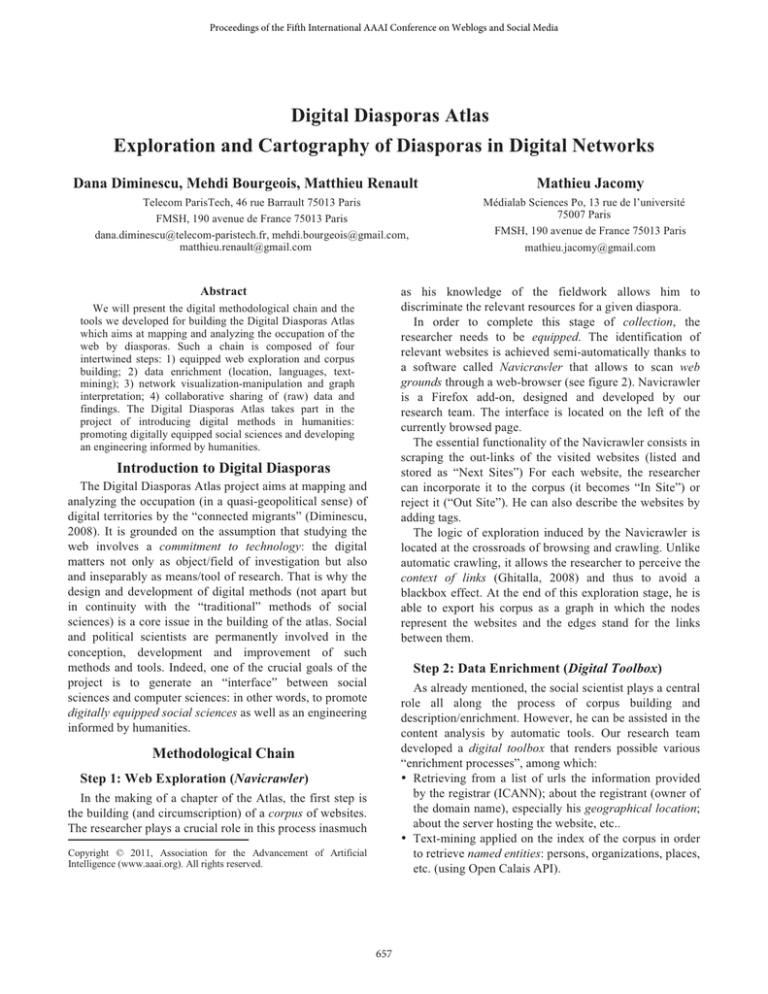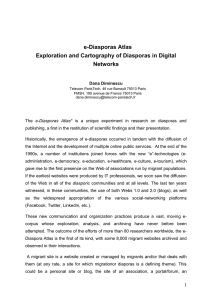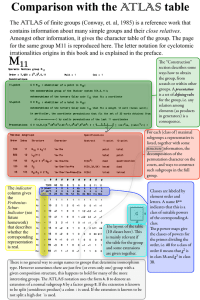
Proceedings of the Fifth International AAAI Conference on Weblogs and Social Media
Digital Diasporas Atlas
Exploration and Cartography of Diasporas in Digital Networks
Dana Diminescu, Mehdi Bourgeois, Matthieu Renault
Telecom ParisTech, 46 rue Barrault 75013 Paris
FMSH, 190 avenue de France 75013 Paris
dana.diminescu@telecom-paristech.fr, mehdi.bourgeois@gmail.com,
matthieu.renault@gmail.com
Mathieu Jacomy
Médialab Sciences Po, 13 rue de l’université
75007 Paris
FMSH, 190 avenue de France 75013 Paris
mathieu.jacomy@gmail.com
as his knowledge of the fieldwork allows him to
discriminate the relevant resources for a given diaspora.
In order to complete this stage of collection, the
researcher needs to be equipped. The identification of
relevant websites is achieved semi-automatically thanks to
a software called Navicrawler that allows to scan web
grounds through a web-browser (see figure 2). Navicrawler
is a Firefox add-on, designed and developed by our
research team. The interface is located on the left of the
currently browsed page.
The essential functionality of the Navicrawler consists in
scraping the out-links of the visited websites (listed and
stored as “Next Sites”) For each website, the researcher
can incorporate it to the corpus (it becomes “In Site”) or
reject it (“Out Site”). He can also describe the websites by
adding tags.
The logic of exploration induced by the Navicrawler is
located at the crossroads of browsing and crawling. Unlike
automatic crawling, it allows the researcher to perceive the
context of links (Ghitalla, 2008) and thus to avoid a
blackbox effect. At the end of this exploration stage, he is
able to export his corpus as a graph in which the nodes
represent the websites and the edges stand for the links
between them.
Abstract
We will present the digital methodological chain and the
tools we developed for building the Digital Diasporas Atlas
which aims at mapping and analyzing the occupation of the
web by diasporas. Such a chain is composed of four
intertwined steps: 1) equipped web exploration and corpus
building; 2) data enrichment (location, languages, textmining); 3) network visualization-manipulation and graph
interpretation; 4) collaborative sharing of (raw) data and
findings. The Digital Diasporas Atlas takes part in the
project of introducing digital methods in humanities:
promoting digitally equipped social sciences and developing
an engineering informed by humanities.
Introduction to Digital Diasporas
The Digital Diasporas Atlas project aims at mapping and
analyzing the occupation (in a quasi-geopolitical sense) of
digital territories by the “connected migrants” (Diminescu,
2008). It is grounded on the assumption that studying the
web involves a commitment to technology: the digital
matters not only as object/field of investigation but also
and inseparably as means/tool of research. That is why the
design and development of digital methods (not apart but
in continuity with the “traditional” methods of social
sciences) is a core issue in the building of the atlas. Social
and political scientists are permanently involved in the
conception, development and improvement of such
methods and tools. Indeed, one of the crucial goals of the
project is to generate an “interface” between social
sciences and computer sciences: in other words, to promote
digitally equipped social sciences as well as an engineering
informed by humanities.
Step 2: Data Enrichment (Digital Toolbox)
As already mentioned, the social scientist plays a central
role all along the process of corpus building and
description/enrichment. However, he can be assisted in the
content analysis by automatic tools. Our research team
developed a digital toolbox that renders possible various
“enrichment processes”, among which:
• Retrieving from a list of urls the information provided
by the registrar (ICANN); about the registrant (owner of
the domain name), especially his geographical location;
about the server hosting the website, etc..
• Text-mining applied on the index of the corpus in order
to retrieve named entities: persons, organizations, places,
etc. (using Open Calais API).
Methodological Chain
Step 1: Web Exploration (Navicrawler)
In the making of a chapter of the Atlas, the first step is
the building (and circumscription) of a corpus of websites.
The researcher plays a crucial role in this process inasmuch
Copyright © 2011, Association for the Advancement of Artificial
Intelligence (www.aaai.org). All rights reserved.
657
• Recognition of the languages used in each website (and
the distribution of languages in order to study
multilinguism, an important issue in migration studies).
corpus of a digital diaspora is dynamically archived in
collaboration with one of our research partner.
Step 3: Network Visualization (Gephi)
In order to visualize the exploration data, in other words
to map the corpus previously built, we use a software of
graph visualization named Gephi, a project initiated and
hosted at its beginnings by our research team. This tool
allows to spatialize and manipulate the corpus network.
Two types of visualization are available:
• a spatialization based on the physical principle of
attraction/repulsion (according to the presence or
absence of a link between two nodes)
• a geographical spatialization that uses geocoded data:
location of websites’ owner, websites’ addressees,
servers, etc. (especially information retrieved during the
data enrichment stage)
By handling the network, by observing its evolution
(timeline), by visualizing the place and the connections of
a given website, by identifying clusters, by filtering the
data by categories, in brief by interpreting the graph, the
researcher produces various representations (or views) of
the corpus that allow him to formulate hypothesis of
research that will be supported (or not) by other
online/offline fieldwork investigations.
Figure 2: Maps and statistics with the GEXF Atlas
Work-in-Progress: Dealing with
Social Media
The conception of the methodological chain hitherto
presented takes its roots in the “web 1.0 age”… before the
spreading of web 2.0 applications, especially among
migrant communities. Now dealing with the social web,
and especially social networking sites demands original
methods.
Using Facebook’API, we developed a Social explorer
that allows: 1) to store dynamically (settable frequency) the
(egocentric) social graph of a user and its evolution. We
especially use it to observe the changes in newly arrived
migrants’ social networks; 2) to store the social graph
corresponding to a Facebook group, in order, notably, to
identify “individuals-authorities”, subgroups, etc. It helps
us to reconsider the structuring of formal and informal
migrants organizations. Such graphs are used as supports
in traditional interviews.
Step 4: Collaborative Platform (Gexf Atlas)
The Gexf Atlas is a “generic” collaborative platform
first developed and implemented for hosting the digital
diasporas atlas (see Figure 2). It is a tool for publishing and
sharing research findings among scientific communities. It
is composed of chapters (in our case, the various
diasporas) and provides for each of them the following
data:
• Maps: browsable graphs of the corpus, with different
views according to the fields of classification.
• Raw data: the empirical data (texts, videos, images
interviews, etc.) produced/retrieved and used during the
research. The Digital Diasporas Atlas is part of the more
general “digital humanities” project of providing access
and diffusing not only the research results but also the
research data.
• Statistics : they are automatically generated from both
the classification and the graph structure and provide
quantitative data about the relations between
categories/actors. Statistics help strengthening the
hypothesis formulated from the graph visualization.
References
Diminescu, D., 2008, “The Connected Migrant: an
Epistemological Manifesto”, Social Sciences Information, vol 47,
n°4.
Ghitalla, F., 2008, “La carte, Un media entre sémiotique et
politique”, Communication et langages, n°158, pp. 61-75.
Let us add that all the steps composing the
methodological chain are fundamentally intertwined and
applied recursively, in such a way that one could talk about
a circular methodology. At the “exit” of the circle, the
658




